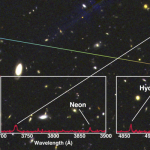W. M. Keck Observatory press release…
An International team led by scientists at ETH Zurich in Switzerland used the W. M. Keck Observatory to study the role of star formation rates in metal contents of distant galaxies. What they discovered is the amount of metals are very similar, irrespective of galaxies’ star formation activity, raising new questions about star-forming theory. Their findings were recently published in the Astrophysical Journal.

The team found typical galaxies forming stars in the Universe two billion years after the Big Bang have only twenty percent of metals (elements heavier than Helium) compared with those in the present day Universe. They also discovered the metal content is independent of the strength of the star-formation activity – in stark contrast with what is known for recently formed, or nearby galaxies.
“The galaxies we studied are very faint because they are so far away that light needs more than 11 billion years to reach us,” said Masato Onodera, the lead author of the paper. “Therefore, the superb light-gathering ability of the 10 meter Keck Observatory telescope was crucial to accomplish this study.”
Gathering the photons is only part of the job, breaking it down into data that could be analyzed by the team was the job of Keck Observatory’s latest instrument, MOSFIRE.
“MOSFIRE allowed us to observe multiple objects simultaneously with an exquisite sensitivity, enabling us to collect spectra of many galaxies very efficiently,” he said. “We saw number of spectral features emitted by ionized atoms in the galaxies such as hydrogen, oxygen, and neon, which allowed us to determine the metal content of the galaxies.”
In addition to the telescope time awarded to them through the California Institute of Technology, the team exchanged valuable time on the 8-meter Subaru Telescope, also on Maunakea, for enough time on Keck Observatory to complete the research.
Metal content in star-forming galaxies is the result of a complex interplay between gas coming into the galaxy, star formation in the galaxy, and gas outflowing from the galaxy in the cosmological context. How much metal is in the system and whether the correlation between the metal content and star formation activity exists provide important clues how galaxy evolve in a distant Universe.

